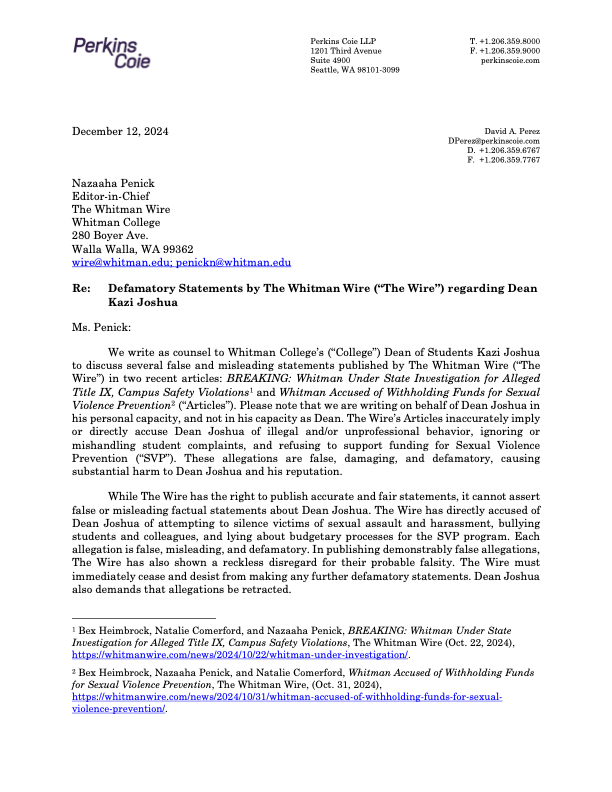The Student Engagement Center (SEC) recently opened up applications for its summer internship grants. The grants, at 2,500 dollars each, are a core part of the SEC’s rapidly expanding internship program. The program more than quadrupled in size, from 30 grants to 130, between 2011 and 2014.
Whitman and the SEC have begun increasing their focus on internships. This summer, Internship Coordinator Victoria Wolff and Director for Business Engagement Kim Rolfe were hired by the SEC to help increase focus on its internship program. The growth in Whitman-funded internships also benefits from a 1.25 million dollar endowment established with the purpose of increasing students’ internship opportunities. The endowment pays out five percent annually, about $62,000. The program also benefits from a number of non-endowment donors who ask that their donations be made immediately payable.
“There’s just been a lot of interest from the college,” said Wolff. “President [George Bridges’] vision is that every student that goes to Whitman has a chance to do an internship [or research opportunity].”
Whitman’s increased focus on internships in recent years stems from the fact that employers are giving more importance to internship experiences when they make hiring decisions, according to Leavitt.
“We know that [internships are] where incredible learning happens, and we also know that that’s what employers are expecting students coming out of undergraduate experiences to have … because [employers are] not doing the training anymore on their end, like they used to do five or ten years ago,” said Associate Dean for Student Engagement Noah Leavitt. “The whole world of work has changed so that things that used to happen at the employer are now having to happen during college.”
Demand for internship grants among students has risen dramatically in the past several years. Only 29 students applied for grants in 2006, and 21 of them were accepted In 2010 and 2011 the SEC fielded 71 applications, and fewer than half of applicants in those years received grants. This spurred a dramatic expansion, and in 2012 the SEC was able to offer grants to 76 of 84 applicants.
These rises in interest and funding have provided the motivation and resources for the SEC to experiment with its programs. This summer, three students took internships at ProtoParadigm, a Walla Walla-based company that produces 3D printers and composites used in them. This led to a cost-sharing arrangement between the SEC and ProtoParadigm, hitherto unprecedented at Whitman. The SEC agreed to foot a part of the bill for those students’ internships, while ProtoParadigm covered the rest.
“At the same time that we want to be incredibly frugal about the way we spend our internship grant dollars … We’re looking to figure out ways to make [opportunities] available,” said Leavitt. “We’re just kind of experimenting.”
Also new to the grant program is an optional budget statement, which allows students to document internship-related expenses and apply for a refund from the college. The statement is intended to help increase the accessibility of internships to students with high financial need by ensuring that they can meet their obligations to the Department of Financial Aid.
“In the past it’s been hard for us to say if we’re giving out these 2,500 dollar grants, that we can assure that you’ll come out of the summer with … whatever the college’s requirement is,” said Leavitt. “We don’t want people to miss out on [internships] because their financial aid package says that they need to finish their summer with 2,400 dollars or 2,500 dollars.”
This year, applications for summer internship grants will be accepted in two waves, with a new deadline in March for earlier submission, as well as the traditional deadline in April. Wolff hopes that the addition of a March deadline will help students and their potential supervisors make decisions regarding their internships earlier.
“In the past, there was one deadline right after spring break, and we’ve gotten feedback from students that said, ‘Well, I need to know earlier on, or my employer needs to know earlier on, whether I’ll get the grant,'” said Wolff. “Those that need to know earlier on can now apply earlier and then get back to their supervisor … and those who are applying for different programs can…use the second deadline.”
Senior Katie Myers, who held an internship with Idaho Representative Mike Simpson two summers ago, is a particular supporter of the internship grant program. It helped her out of a tight spot in the months leading up to her internship.
“Originally, it was going to be a paid internship … but then the government shutdown happened,” she said. “The first thing I did was run over to the SEC, and luckily the deadline hadn’t passed yet. It was about two days away … It’s really expensive to live [in Washington, D.C.], so without the grant, it probably wouldn’t have been possible.”
Myers now plans to join the cohort of donors to the internship grant program some day.
“I used to work at the office of annual giving,” she said. “And so I have thought that, in the future, when I’m in a position to give, I would really like to give to the internship grants because it was something that will propel me into the career that I want.”
At the time of writing, Leavitt and Wolff could offer no estimates for the number of grants offered this year. Budgeting decisions are usually put off until the spring semester because donors tend to make their contributions late in the fiscal year for tax filing purposes.




